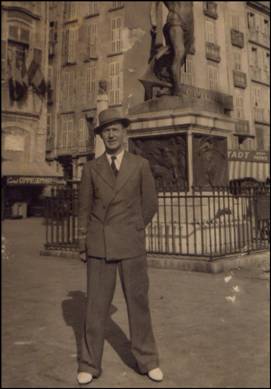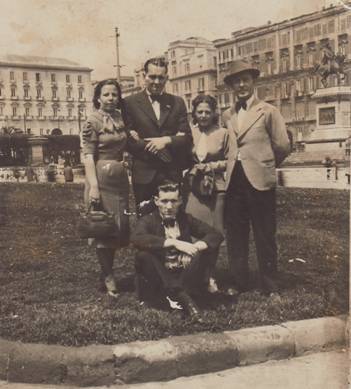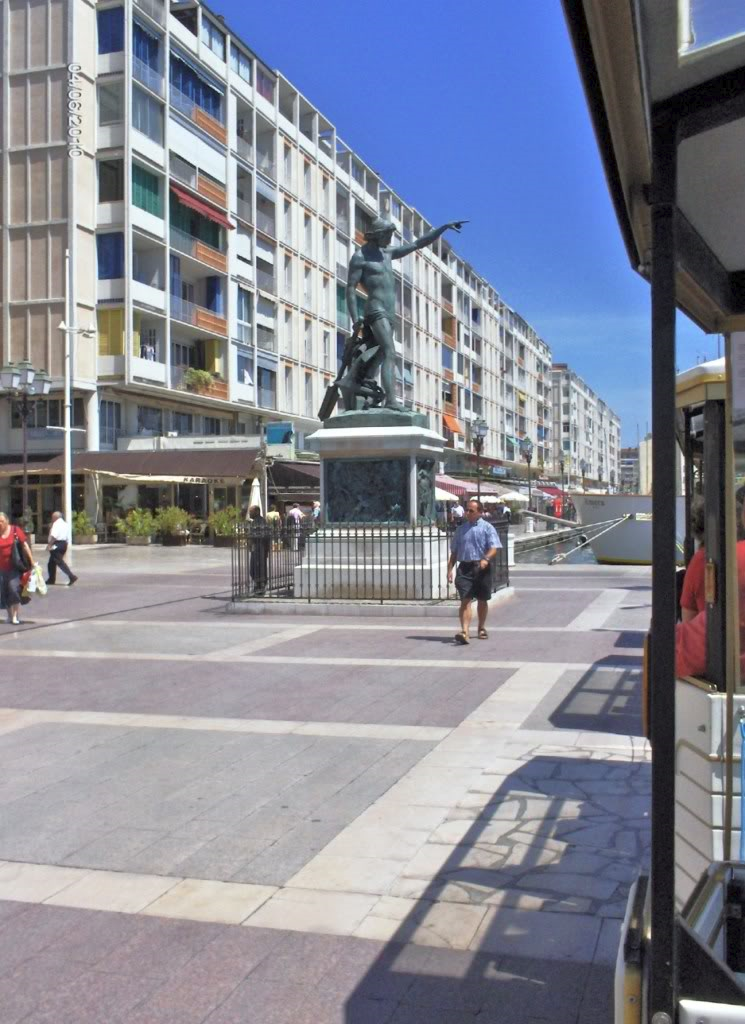I have been trying to identify the City (English, Italian, French or other) and the Greek or Roman "Mariner" Statue in photo
1. Can you suggest a place I could post Photo 1 to get it identified? My dad was enlisted /employed on the *Oronsay, Moreton Bay, Largs Bay *between 28 Jan 1938 and 30 July 1939 and then as a
passenger* Nov 1939 *on *the Strathnaver* to Australia.
These photos taken of my father between Mar 1938 and Dec 1939.
Perhaps the people in photo 2 are fellow shipmates on shore leave also? He was employed on the Oronsay

Joseph Horan c1938-39
Passport No. A192701 issued> *Issued Sydney NSW - Passport expires: 27/1/1943***
*Continuous Certificate of Discharge* No. R178821
Oronsay Ship No. 147948
Rating: Assistant Steward -- Described as: Height: 5.9"
Eyes: Blue
Grey Hair: Fair Hair Complexion: Fair
Thanking you in anticipation.
Toulon's story is a bit like Marseille's, only on a
smaller scale:
industrious, noisy, busy, a melting pot - a wonderful
place if you like
to live in a vibrant city, not so great if you are looking
for peace and
charm. In other words it does not have to be on your list
of sights you
absolutely need to visit in the Provence. But there are
some interesting
places in town and the villages of Mourillon to the east
and Saint
Mandrier southwest are quite beautiful vacation locations
well known to
the French. The scenery is supreme: Toulon is situated
between a
mountain range topped by Mont Faron and Mont Caume and the
Rade de
Toulon, a large bay protected from the sea by two
peninsulas. It is the
major naval port of the French fleet in the Mediterranean.
Toulon's population is about 170.000, the metropolitan
area counts
roughly 520.000 inhabitants.
History
The first immigrants on record were the Greeks in the 7th
century BC,
then the Celto-Ligurians in the 4th century BC and finally
the Romans in
the 2nd century BC. They called the small settlement Telo
Martius -
Telo, either for the goddess of springs or from the Latin
tol, the base
of the hill - and Martius, for the god of war. Telo
Martius became was
known for producing the red dye used in the purple color
of imperial
robes. It was made from the murex, a local sea snail
abundant on the
rocks around here. The area provided an excellent natural
harbour for
ships and the settlement and changed its name over the
centuries from
from Telo to Tholon or Tolon in the Provençal language and
Toulon in
French. In the 5th century, the Roman Empire was about to
end, Toulon
was christianized like the rest of the Provence. During
the following
centuries it suffered terribly from invasions by pirates,
barbarians and
finally the Saracens. In the 11th century the Counts of
Provence took
control and in 1486 most of the Provence and with it
Toulon became a
part of France. In 1494 Charles VIII had the first
military shipyard
established here and from then on Toulon became the main
naval port in
the Mediterranean Sea for France. The construction of the
Tour Royale,
protecting the harbor, was finished in 1524. In the 17th
century, under
Louis XIV and his Minister Colbert, naval fortifications
were
significantly expanded. During the French Revolution,
Toulon is handed
to the British fleet by its Royalist inhabitants. But the
British are
expelled by a French force whose artillery is led by a
certain Napoleon
Bonaparte. From 1803 to 1805 Toulon was blockaded by the
British fleet
under Admiral Nelson. When the German Army occupies
southern France in
November 1942 the French scuttled their fleet in Toulon.
One year later
the Allied bombings destroys most of the port at great
loss of life.
Finally, in August 28, 1944 Toulon is liberated by the
Allied Forces.
<http://www.viamichelin.fr/viamichelin/gbr/dyn/controller/Cartes-plans?mapId=-t8vtcokyoacq0o&initialMap=mapid&dx=473&dy=200&empriseW=947&empriseH=400>
The Town
The place where most visitors end up is Quai Stalingrad
between the
inner port and the Vieille Ville, the old town. The
buildings directly
at the inner port with its pretty quay are non-descript
modern - the
result of some unfortunate decisions made when rebuilding
this area
after World War II. But walking along the quay with many
boats and
yachts on one side and cafés and restaurants on the other
side is
relaxing and you overlook the architecture behind it. The
*Rade de
Toulon*, rade means a protected place for ships to anchor,
is one of the
best natural anchorages on the Mediterranean, and after
Rio de Janeiro
the world's second largest. The Peninsula of Giens and the
Peninsula of
Saint Mandrier sur Mer protect it from the sea. The Rade
shelters the
port of Saint Mandrier sur Mer, the port of La Seyne sur
Mer, as well as
both the arsenal (naval port) and the commercial port of
Toulon. The
arsenal, home of the French Mediterranean fleet, is not
open to the
public. But you can visit the Musée Naval de la Marine
<http://www.musee-marine.fr/site/fr/toulon_presentation>,
Naval Museum
at the western end of Quai Stalingrad with its impressive
doorway. You
will be amazed even if you are not into naval history by
the remarkable
collection of enormous ship models from the 18th century
as well as
other naval memorabilia, such as figureheads and carvings.
You find a
number of works from Pierre Puget (1620 - 1694), a
sculptor, architect
and painter, a native of Marseille. Amongst the paintings
is a huge
fresco of old Toulon is by Joseph Verner. From Quai
Stalingrad boat
trips take you to the Petite Rade, a trip that includes
the arsenal and
dry docks. You can have a good look at ships of the French
fleet or
rather what's left of it after decades of underinvestment.
Musée de la Marine



